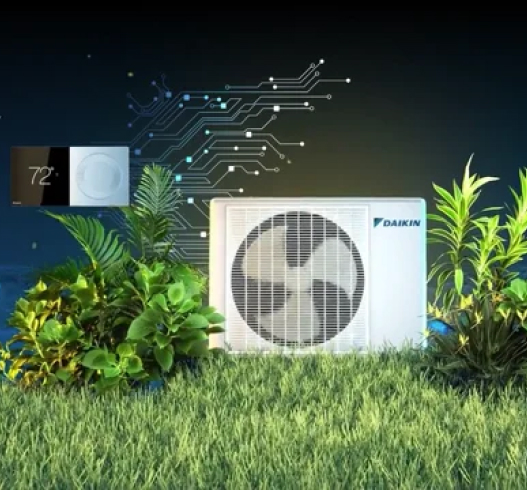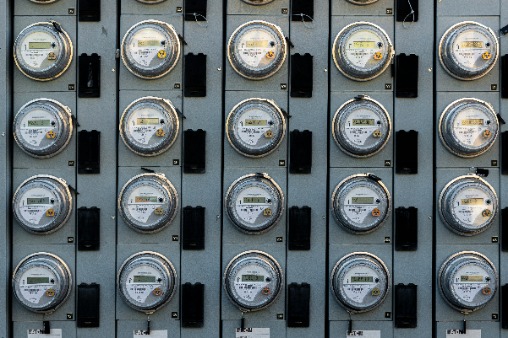The Guide to Ductless Mini-Split HVAC Systems

Ductless heating and cooling systems have grown in popularity in recent years as more people become aware of their many benefits. While ducted systems are still a very common type of HVAC system, there are several reasons why ductless systems may be a great choice for your home.
What Your Guide to Ductless Mini-Split Heating and Cooling Systems
Imagine having ultimate control over your home's temperature, tailored for each room and each person's preference. Now, add energy efficiency into the mix to help control energy use. Substantial benefits like those are helping to drive North American homeowners to discover ductless mini-split heating and cooling systems – an indoor comfort solution that homeowners in Europe and Asia have embraced for years.
In fact, worldwide demand for ductless cooling and heating systems is expected to double by 2030.1 Ductless HVAC systems offer an additional option for heating and cooling North American homes by providing flexibility, outstanding indoor comfort, and even potential energy savings.
What Are Ductless Mini-Split HVAC Systems?
True to their name, ductless heating and cooling systems, also known as mini-splits, eliminate the need for extensive ductwork. This helps make it easy for a heating, ventilation, and air conditioning (HVAC) professional to install with minimal disruption to a home’s existing architecture. Mini-splits consist of indoor units mounted to a wall, floor, or ceiling that distribute conditioned air. They connect directly to an outdoor condensing unit by piping, which is often smaller and quieter than traditional, cube-style central air conditioning or heat pump units found throughout typical North American neighborhoods.
Central AC and central heat pumps, known as “split systems” rather than “mini-split systems,” use a complex network of ducts to force conditioned air throughout several rooms or the entire house—often cooling or heating spaces that aren’t being used. Both types of systems are “split” because they consist of an indoor unit and an outdoor unit. Alternatively, ductless systems allow specific rooms—and even whole houses—to be cooled or heated in a highly efficient, targeted manner.
How do Ductless HVAC Systems work?
Ductless systems are simple yet effective in the home. These systems operate by using two main parts: an indoor unit and an outdoor unit.
When operating in cooling mode, the indoor unit pulls in unwanted hot air. This air passes over coils, which contain a special fluid called refrigerant, which absorbs the heat from the air. The air temp is now colder and discharged back into the room to keep you comfortable. The refrigerant now contains the unwanted heat that travels through small pipes to the outdoor unit. Outside, the refrigerant releases the heat, which is then sent outside through coils in the outdoor unit. This process helps keep your home comfortable without the need for ductwork.
When in heating operation, the reverse happens. Cold air inside the home is replaced with warmer air, thanks to the heat transfer occurring between the coils and refrigerant in the outdoor unit and sending it indoors.
A convenient remote control helps homeowners to easily adjust temperature settings to their liking. The remote control also engages features that can direct airflow in 4 directions, adjust fan speed, and set timers.
Key Features of Ductless Systems
When considering a ductless system, it’s important to understand its unique capabilities. Here are some compelling features:
High SEER2 Ratings
Ductless mini-split systems have earned a stellar reputation for their impressive Seasonal Energy Efficiency Ratio 2 (SEER2) ratings, showcasing remarkable efficiency that may result in substantial savings on utility bills.2
SEER2 measures an air conditioner’s maximum energy efficiency during a typical cooling season. Systems with high SEER2 ratings may cost more initially, but their low operating costs can often help save money in the long run compared to lower SEER units. The U.S. Department of Minimum SEER2 requirements were updated in 2023 and vary by region; look yours up here.
For example, split system air conditioners (<45k BTU) for homes in the warm, humid Southeast now require a minimum SEER2 rating of 14.3 SEER2. By comparison, ductless systems such as the Daikin OTERRA provide up to 20 SEER2 performance, which can meaningfully reduce monthly utility costs when compared to a lower SEER2 unit.
Inverter Technology
Inverter-driven ductless systems are designed to maximize energy efficiency. They also help enhance indoor comfort by minimizing the uncomfortable temperature swings commonly produced by non-inverter HVAC systems.
Inverter-driven units continually regulate cooling and heating capacity. They accomplish this by varying compressor speeds to match demand, which is the capacity needed to cool or heat a room. After reaching the desired indoor temperature, inverter units are designed to run at a slow, energy-conserving speed, constantly maintaining that temperature. Since the indoor air keeps moving, slowly cycling through the system, humidity levels can be consistently regulated. Non-inverter air conditioners tend to cycle on and off, which causes large spikes in energy usage and indoor temperatures to fluctuate.
The result? Inverter technology can reduce energy consumption compared to standard, non-inverter air conditioners.3
Intelligent Eye Sensor
Some ductless air conditioners feature an intelligent eye sensor that can detect human presence in a room using infrared technology. When no movement is detected over time, the system automatically shifts into an energy-saving mode. This feature may save up to 20% in cooling and up to 30% in heating operations compared to ductless systems without intelligent eye.4
Powerful mode
When you need to cool or heat a space quickly, some units have a feature called powerful mode. The system typically operates at maximum capacity for a pre-set number of minutes in this mode.
Advantages of Ductless Systems
From energy efficiency to quick, professional installation, ductless HVAC systems are ideal for many indoor environments.
Energy Efficiency
Aging ductwork used by central, forced-air systems is notorious for losing efficiency due to leaks or exposure to hot, unconditioned spaces such as attics. Remarkably, duct losses can account for more than 30[TM1] % of air conditioning’s energy consumption, according to Energy.gov.5 Ductless systems naturally minimize this issue by eliminating ductwork.
Zoning Capabilities
An exciting feature of ductless units is their ability to scale by zoning. An indoor unit in each room provides reliable temperature control while delivering efficient, precise energy use. Zoning provides an excellent energy-efficient solution in homes where some rooms may not always be used or occupied—or are challenging to cool and heat.
Easy Installation
Ductless HVAC systems eliminate the need for complex ductwork, making them simple for HVAC contractors to install while keeping a home’s architectural integrity intact. Compact outdoor condenser units connect to indoor units using a narrow refrigerant conduit. Typically, professional installation can be completed within one day, saving time and labor costs.
Reduced Noise
Did you know that a normal conversation sound level is around 60 decibels?6 The outdoor compressor units of many ductless heat pumps and air conditioners often run low as 56 dB(A), such as with Daikin Multi-zone ductless systems. Like the wall-mounted Daikin EMURA, the indoor portion can produce sound levels down to 19 dB(A), making for a whisper-quiet experience.
Air Quality
Ductless systems can help improve indoor air quality. Their filters can trap dust and other airborne particles, and many are washable.
What About Multi-Zone Ductless Systems?
Multi-zone ductless systems provide your ultimate whole-home comfort control. Imagine setting the perfect temperature for every room, tailored to each family member's preference.
Multi-zone ductless systems bring the advantages of single-zone mini-splits to multiple areas in your home. In a multi-zone system, a single outdoor condenser unit can connect with several indoor units, providing customized heating and cooling per living space.
[TM1]Different percentages are used in the other materials you provided. A different source is cited for this point as well.
Multi-zone systems are designed to offer remarkable energy efficiency. They allow you to heat or cool only the specific zones in use, conserving energy in unoccupied rooms. This zoning capability may help reduce energy bills compared to traditional split systems, making multi-zone mini-splits a cost-effective indoor comfort solution over the long run.
Multi-zone systems may help solve indoor comfort challenges for large homes with several rooms or households with varied heating and cooling needs. Each zone can be installed and managed independently for customized indoor comfort—ideal for spaces like a home office addition, a baby's room needing extra warmth, or a basement that may be too hot or too cool.
Advanced Home Comfort, Sustainability, and the Smart Home Evolution
With their renowned energy efficiencies, ductless HVAC systems may help play a role in the global quest for sustainability. As utility companies transition toward more sustainable energy sources, efficient, electric-powered ductless systems are primed to take advantage of solar and wind power generation.
However, they are also gaining favor as pivotal companions to smart home technology. Their ability to integrate seamlessly with smart thermostats and home infrastructure opens new possibilities. Consider the prospect of a custom automation that allowed your mini-split air conditioner to coordinate with your intelligent home lighting or automated blinds, working harmoniously to optimize comfort and power conservation.
Ductless vs. Ducted Systems
Both ductless mini-split and central ducted-split systems are designed to create satisfying indoor comfort. However, their operation and installation needs are fundamentally different.
To see what a ductless system would look like in your space, consider trying out Daikin’s Augmented Reality Experience. Here, you can see what a single or multi-zone system looks like in your space. If a specific model appeals to you, you can even create a list of “favorites” to share with your contractor. Homeowners should consider discussing their specific needs with a local Daikin contractor to understand the benefits of each type of system.
For homeowners seeking exceptional energy efficiencies, room-by-room temperature customization, simple professional installation, and quiet operation, ductless mini-splits can provide an outstanding indoor comfort solution.
Homeowners HVAC Guide: Ultimate Zoned Comfort
1 Zion Market Research, Ductless Heating & Cooling Systems Market Size is projected to reach USD 205.1 Billion by 2030, growing at a CAGR of 8.5%
2 U.S. EPA Consumer Messaging Guide for ENERGY STAR Certified Mini Splits,
3 SSRN, Comparison of Energy Consumption Between a Standard Air Conditioner and an Inverter Type Air Conditioner in an Office Space
4 Daikin Comfort Technologies, https://backend.daikincomfort.com/docs/default-source/product-documents/residential/brochures/cb-daikin-smzs.pdf
5 Energy.gov, Ductless Mini-Split Air Conditioners https://www.energy.gov/energysaver/ductless-mini-split-air-conditioners#:~:text=Since%20mini%2Dsplits%20have%20no,space%20such%20as%20an%20attic.
6 County of San Diego, Sound Levels of Typical Noise Sources and Noise Environments,
https://www.sandiegocounty.gov/dplu/docs/081024/TM5499-NOISE-T.pdf
In this article
Connect on Social Media
 Follow on Facebook
Follow on Facebook
 Follow on YouTube
Follow on YouTube
 Follow on Instagram
Follow on Instagram
 Follow on X
Follow on X
 Follow on TikTok
Follow on TikTok
 Follow on Pinterest
Follow on Pinterest

Looking for help now?
Enter your zip code to search for Daikin Contractors in your area.
Learn More
Learning Center Content
Stay informed about home comfort technology, when to upgrade, energy efficiency, and reducing your energy bills.





























